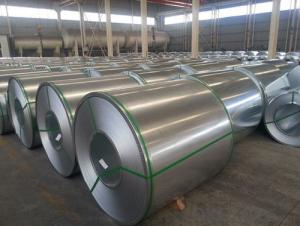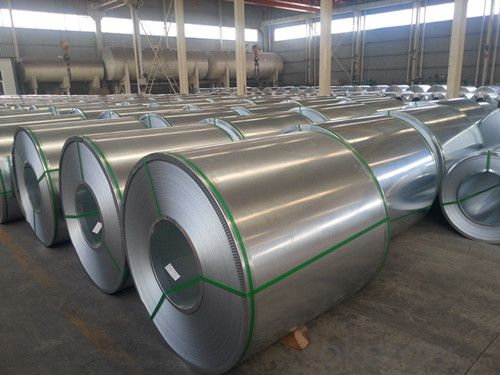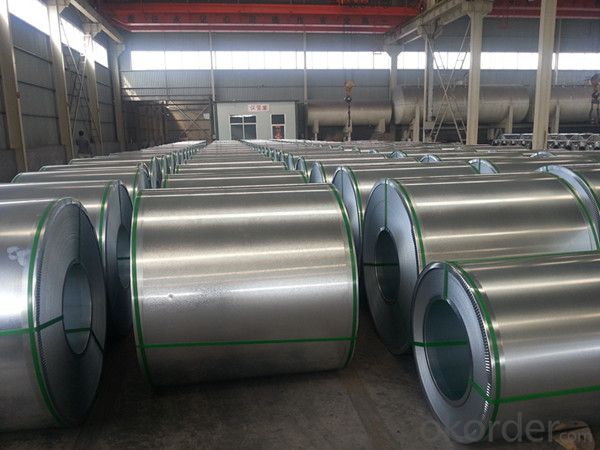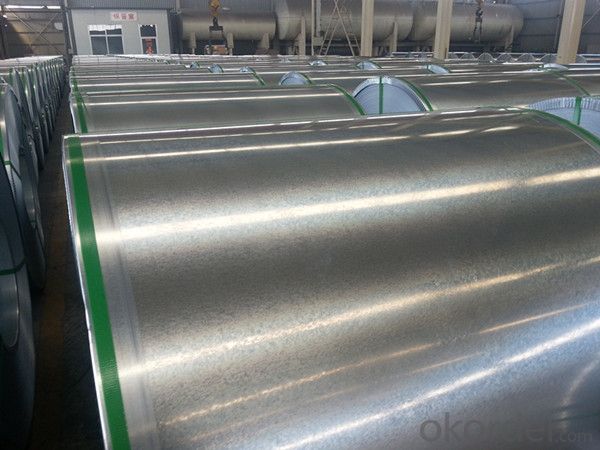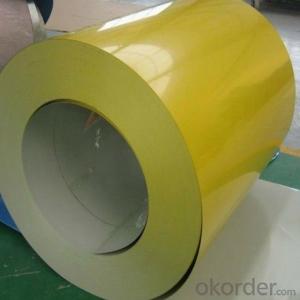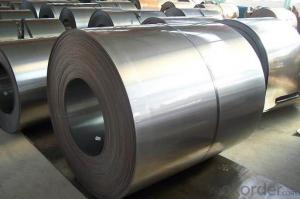Galvanized Steel Coils/Sheets from China CNBM
- Loading Port:
- China main port
- Payment Terms:
- TT OR LC
- Min Order Qty:
- 25 m.t.
- Supply Capability:
- 100000 m.t./month
OKorder Service Pledge
OKorder Financial Service
You Might Also Like
Product Description:
OKorder is offering high quality Cold rolled Hot Dip Galvanized Steel Coil at great prices with worldwide shipping. Our supplier is a world-class manufacturer of galvanized steel, with our products utilized the world over. OKorder annually supplies products to European, North American and Asian markets. We provide quotations within 24 hours of receiving an inquiry and guarantee competitive prices.
Product Applications:
Cold rolled Hot Dip Galvanized Steel Coil is ideal for fabricating and manufacturing applications.
Product Advantages:
OKorder's Galvanized Steel Coil is durable, boasts high stiffness and load-bearing qualities, and is recyclable.
Main Product Features:
· Premium quality
· Prompt delivery & seaworthy packing (30 days after receiving deposit)
· Corrosion resistance
· Can be recycled and reused
· Mill test certification
· Professional Service
· Competitive pricing
Product Specifications:
Manufacture: Hot rolled
Coil ID: 508mm
Coil OD: 900-1500 mm
Grade: DX51D+Z
Coating: 30 – 180g/m² (both sides)
Dimensions:
Thickness: 0.2mm – 1.0mm
Width: 600mm, 914mm, 1000mm, 1220mm, 1250mm
Coil Weight: 4 – 6mt
Length: 6m, 9m, 12m
FAQ:
Q1: Why buy Materials & Equipment from OKorder.com?
A1: All products offered byOKorder.com are carefully selected from China's most reliable manufacturing enterprises. Through its ISO certifications, OKorder.com adheres to the highest standards and a commitment to supply chain safety and customer satisfaction.
Q2: How do we guarantee the quality of our products?
A2: We have established an advanced quality management system which conducts strict quality tests at every step, from raw materials to the final product. At the same time, we provide extensive follow-up service assurances as required.
Q3: How soon can we receive the product after purchase?
A3: Within three days of placing an order, we will begin production. The specific shipping date is dependent upon international and government factors, but is typically 7 to 10 workdays.
Q4: What makes stainless steel stainless?
A4: Stainless steel must contain at least 10.5 % chromium. It is this element that reacts with the oxygen in the air to form a complex chrome-oxide surface layer that is invisible but strong enough to prevent further oxygen from "staining" (rusting) the surface. Higher levels of chromium and the addition of other alloying elements such as nickel and molybdenum enhance this surface layer and improve the corrosion resistance of the stainless material.
Q5: Can stainless steel rust?
A5: Stainless does not "rust" as you think of regular steel rusting with a red oxide on the surface that flakes off. If you see red rust it is probably due to some iron particles that have contaminated the surface of the stainless steel and it is these iron particles that are rusting. Look at the source of the rusting and see if you can remove it from the surface.
Q6: What is the difference between galvanized steel and Galvalume steel?
A6: Galvanized steel is metallic coated with Zinc in various coating weights. Minimum recommended for painted metal roofs is G90. Galvalume is a zinc and aluminum coated steel that becomes an alloy and is recommended in either painted or bare applications with a minimum coating weight of AZ50. Galvalume has an excellent performance life in bare exposures. Hence if you are using a bare panel use Galvalume and if painted use either.
Images:

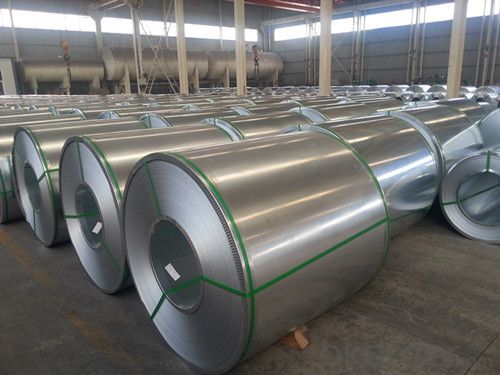
- Q: Well the other day i told my friend that when you put a compass near steel it will screw up and he said only magnets do that then i showed him and it worked then he said: that'ss because steel has its own magnet in it coz it builds up static electricity is that correct what he said? thanks
- If you sprinkle iron filings near a bar magnet (on paper, etc.) the filings will try to line up with the magnetic field (because iron atoms behave like tiny magnets). Bringing the compass near steel (mainly iron with a little carbon) will cause the iron to try to align with the magnet of the compass needle, however, because the needle is free to swing it also aligns with the magnetic field set up between the needle and steel. Any static electricity would have nil effect on the magnetic field.
- Q: How are steel coils used in the production of metal fencing?
- Steel coils are used in the production of metal fencing as they serve as the raw material for creating the wire mesh that forms the structure of the fence. The steel coils are uncoiled and then passed through a series of machines that shape and weld them into the desired fence panels or rolls. These panels are then further processed and treated to enhance their durability and resistance to corrosion, ultimately resulting in high-quality metal fencing products.
- Q: How do steel coils contribute to the marine industry?
- Steel coils contribute to the marine industry by being used in the construction of ships and offshore structures. They are essential for manufacturing various components, such as hulls, decks, beams, and structural supports. Steel coils provide strength, durability, and corrosion resistance, ensuring the longevity and safety of marine vessels and infrastructure. Additionally, steel coils are used for the production of marine equipment, including cranes, winches, and anchor chains, further enhancing the efficiency and functionality of the marine industry.
- Q: How does stainless steel soap work? I have read the detailed explanation on Wikipedia, but their desciption seems skeptical on the actual chemical process that may take place from using such an item. Is there an actual scientific explanation to how stainless steel soap is able to clean your hands, when it is only a piece of metal?
- Many metals have germicidal qualities. Silver is the strongest germicide of the metals, but a sterling silver bar of soap would be expensive and it would tarnish. The tarnish would actually not affect the silver's ability to kill bacteria, but it would look bad and the tarnish would turn your hands black, so people wouldn't want to use it. Many people even take silver internally in the form of Colloidal Silver, but Colloidal Silver is very controversial. Yes, it kills many bacteria, but it can also cause a person's skin to permanently turn blue...a condition called Argyria. Brass actually is a better germicide than stainless steel...but again this is a cosmetic problem. Brass tarnishes, so people wouldn't want to use it. Stainless steel is actually a very weak germicide, but even steel has some ability to kill germs. Stainless steel also removes fish odor. My son has a stainless steel bar that he takes along when he fishes to remove the fish smell from his hands. There's nothing magical about the bar...a stainless steel spatula would would just as well, but the bar is more convenient to carry. I'm not sure if this is scientific enough or not. -
- Q: What are the different types of steel coil surface treatments for outdoor applications?
- For outdoor applications, there are several commonly used surface treatments for steel coils that enhance durability, corrosion resistance, and appearance. Examples of these treatments include: 1. Galvanized: This treatment involves applying a layer of zinc to the steel surface, providing excellent corrosion resistance. Galvanized steel coils have a shiny, silver appearance. 2. Galvalume: Galvalume is a combination of aluminum and zinc applied to the steel surface, offering superior corrosion resistance compared to galvanized steel. Galvalume steel coils have a duller, matte finish. 3. Painted: Steel coils can be painted with various coatings to enhance appearance and protect against corrosion. The paint can be applied in single or multiple layers, depending on the desired level of protection. Painted steel coils are available in a wide range of colors and finishes. 4. Powder Coated: This type of paint coating is applied as a powder and then cured under heat, resulting in a durable and long-lasting finish. Powder coated steel coils are resistant to chipping, scratching, and fading, making them suitable for outdoor applications. 5. Organic Coated: Organic coatings, such as PVC or PVDF, are applied to steel coils to provide additional protection against corrosion and weathering. These coatings are commonly used in architectural applications where aesthetics and durability are important. These various surface treatments for steel coils offer different levels of protection and aesthetic options for outdoor applications. The choice of treatment depends on factors such as the intended use, environmental conditions, and desired appearance.
- Q: What are the different methods of coil end welding for steel coils?
- There are several different methods of coil end welding for steel coils. These methods include: 1. Resistance Welding: This method involves applying an electric current to the ends of the coils, causing them to heat up and melt together. Resistance welding is commonly used for joining steel coils due to its high efficiency and speed. 2. Laser Welding: Laser welding utilizes a high-energy laser beam to melt and fuse the ends of the steel coils together. This method provides precise control over the welding process and can produce high-quality welds. 3. Tungsten Inert Gas (TIG) Welding: TIG welding uses a non-consumable tungsten electrode and an inert gas, such as argon, to create a protective atmosphere around the welding area. This method is known for producing clean and strong welds, making it suitable for steel coil end welding. 4. Plasma Arc Welding: Plasma arc welding involves using a plasma torch to create an electric arc between the electrode and the workpiece. The intense heat generated by the plasma arc melts the ends of the steel coils, allowing them to be welded together. 5. Electron Beam Welding: Electron beam welding utilizes a high-velocity beam of electrons to heat and melt the ends of the steel coils. This method is often used for joining thick steel coils and offers deep penetration and high welding speed. 6. Friction Stir Welding: Friction stir welding involves a rotating tool that generates friction and heat between the steel coil ends, causing them to soften and fuse together. This method is commonly used for joining aluminum coils but can also be applied to steel coils. These are just a few of the different methods of coil end welding for steel coils. The choice of method depends on various factors such as the desired weld quality, production speed, material thickness, and application requirements.
- Q: I would like to know the process of making steel from the mining of ore to the final product. Can anybody offer some help? Either where to look, or the process itself. I would like to have included the different options with which to make steel. Through scrap metal, or iron ore briquettes etc... Thanks.
- A okorder /.. There are many different types of steels depending on process and ingredient changes that can be found in many engineering books. This will give you the basic flow.
- Q: I have taylormade burner steel irons and I was wondering what would the flex of steel be if you were to compare it to graphite shafts, like regular, stiff, super stiff, etc...THANKS!!!!!!!!!!!!!!!!!!!!!!!!!!!!!!!!!!!!!!
- If i understand you correctly, i think you misunderstand shafts. Steel shafts vs. graphite shafts these days is more of a competition of weights, not flexibility. Both steel and Graphite have different flex profiles available from Ladies (L) to super stiff (X). Graphite may feel a little more whippy than steel because of the lighter weight. Shafts will vary by company as well. Stiff from True temper may not be as stiff as one from Aldila, or vice verse. You can also make a shaft play stiffer or more flexible by where you cut the length. This is called tipping. Take more from the bottom and it will be stiffer, more from the grip end and it will play more flexible.
- Q: density of mild steel (MS) is 7850 KG per metre cube , but i want to know the density of stainless steel
- Stainless steels are the most dense, coming in at 8000 kg/m3. Though the densities vary, The answer is 8000 kg/m3. 301 stainless density values seem to vary according to the supplier data sheets, from 7.88 g/cc, (AK Steel) to 8.03 g/cc, (Allegheny Ludlum)
- Q: I want to make a stock removal knife, but I am really confused about what steel to use. I am just a beginner but I read o1 steel is great? Also I am kind of on a budget.
- O-1 is an excellent steel. If you've never made a knife before find an old file and use it. My first knives weren't that good, it took a little practice to get the geometry right so be prepared to burn some steel. The advantage of a file is it is already hardened, unless you have a torch or forge that will be near imposable for you to do. The most important thing in knife making is the heat treating. The best steel wont perform like it's supposed to. If you decide to use a file grind your blade out, keep the steel cool; do not let it get any color in it (brown, blue, purple) as this destroys the temper. When your finished put the blade in the oven at 400 deg for an hour. It should have a good hardness for a knife then. As for me, I use old car springs(5160), saw blades(L-6) for many of my blades, Good luck.
Send your message to us
Galvanized Steel Coils/Sheets from China CNBM
- Loading Port:
- China main port
- Payment Terms:
- TT OR LC
- Min Order Qty:
- 25 m.t.
- Supply Capability:
- 100000 m.t./month
OKorder Service Pledge
OKorder Financial Service
Similar products
Hot products
Hot Searches
Related keywords
